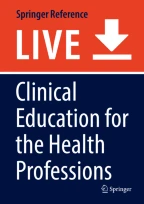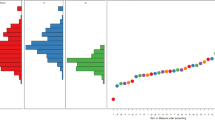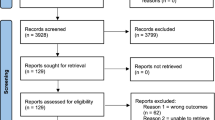Measuring Attitudes: Current Practices in Health Professional Education

Attitudes are an enduring set of beliefs, perceptions, and ideas. Students enrolled in health professional courses may have strong beliefs and opinions on certain topics related to professional education and their clinical practice. These attitudes may become more apparent while health professional students are completing clinical placements. This chapter provides an overview of definitions of what attitudes are; why attitudes are important; how attitudes develop, change, and evolve; approaches to the measurement of and gathering attitude-related data; types of quantitative attitude scales; qualitative approaches to gathering attitude data; the steps involved in constructing an attitude measurement scale; and the relevance of attitudes to health professional clinical education. Academic and clinical educators need to be conversant on the topic of students’ attitudes and its relationship to clinical education.
This is a preview of subscription content, log in via an institution to check access.
Access this chapter
Similar content being viewed by others

Medical students’ attitude towards psychiatry: a comparison of past and present
Article Open access 29 May 2023

Healthcare students’ attitudes towards patient centred care: a systematic review with meta-analysis
Article Open access 27 April 2022
The search for attitude—a hidden curriculum assessment from a central European perspective
Article Open access 22 January 2018
References
- Al-Elq AH. Simulation-based medical teaching and learning. J Fam Community Med. 2010;17(1):35–40. https://doi.org/10.4103/1319-1683.68787. ArticleGoogle Scholar
- Allport GW. Attitudes. In: Murchison CM, editor. Handbook of social psychology. Winchester: Clark University Press; 1935. p. 798–844. Google Scholar
- American Nurses Association. American Nurses Association code of ethics 2015. http://nursing.rutgers.edu/civility/ANA-Code-of-Ethics-for-Nurses.pdf. Accessed 10 Jan 2019.
- Anastasi C. Psychological testing. 6th ed. New York: Macmillan; 1988. Google Scholar
- Australian Medical Association. AMA code of ethics 2016. https://ama.com.au/articles/code-ethics-2004-editorially-revised-2006-revised-2016. Accessed 10 Jan 2019.
- Boateng GO, Neilands TB, Frongillo EA, Melgar-Quiñonez HR, Young SL. Best practices for developing and validating scales for health, social, and behavioral research: a primer. Front Public Health. 2018;6:149. https://doi.org/10.3389/fpubh.2018.00149. ArticleGoogle Scholar
- Brock D, Abu-Rish E, Chiu CR, Hammer D, Wilson S, Vorvick L, et al. Interprofessional education in team communication: working together to improve patient safety. BMJ Qual Saf. 2013;22(5):414–23. https://doi.org/10.1136/postgradmedj-2012-000952rep. ArticleGoogle Scholar
- Carasco JA, Lucas K. Workshop synthesis: measuring attitudes; quantitative and qualitative methods. Transp Res Procedia. 2015;11:165–71. https://doi.org/10.1016/j.trpro.2015.12.014. ArticleGoogle Scholar
- Carpenter S. Ten steps in scale development and reporting: a guide for researchers. Commun Methods Meas. 2018;12(1):25–44. https://doi.org/10.1080/19312458.2017.1396583. ArticleGoogle Scholar
- Chapman EN, Kaatz A, Carnes M. Physicians and implicit bias: how doctors may unwittingly perpetuate health care disparities. J Gen Intern Med. 2013;28(11):1504–10. https://doi.org/10.1007/s11606-013-2441-1. ArticleGoogle Scholar
- Chen A, Yehle M, Plake K. Impact of aging simulation game on pharmacy students’ empathy for older adults. Am J Pharm Educ. 2015;79(5):65. https://doi.org/10.5688/ajpe79565. ArticleGoogle Scholar
- Cocker F, Joss N. Compassion fatigue among healthcare, emergency and community service workers: a systematic review. Int J Environ Res Public Health. 2016;13(6):618. https://doi.org/10.3390/ijerph13060618. ArticleGoogle Scholar
- Crano WD, Gardikiotis A. Attitude formation and change. In: Wright J, editor. International encyclopedia of the social & behavioral sciences. 2nd ed. Amsterdam: Elsevier; 2015. p. 169–74. ChapterGoogle Scholar
- Croke E. The use of structured reflective journal questions to promote fundamental development of clinical decision-making abilities of the first-semester nursing student. Contemp Nurse. 2004;17(1–2):125–36. ArticleGoogle Scholar
- DeCastellarnau A. A classification of response scale characteristics that affect data quality: a literature review. Qual Quant. 2017;52(4):1523–59. https://doi.org/10.1007/s11135-017-0533-4. ArticleGoogle Scholar
- Desarbo W, Ramaswamy V, Chatterjee R. Analyzing constant-sum multiple criterion data: a segment-level approach. J Mark Res. 1995;32:222–32. https://doi.org/10.2307/3152050. ArticleGoogle Scholar
- Desselle SP. Construction, implementation, and analysis of summated rating attitude scales. Am J Pharm Educ. 2005;69(5):Article 97. https://doi.org/10.5688/aj690597. ArticleGoogle Scholar
- Dudek FJ, Baker KE. The constant-sum method applied to scaling subjective dimensions. Am J Psychol. 1956;69(4):616–24. https://doi.org/10.2307/1419084. ArticleGoogle Scholar
- Eagly AH, Chaiken S. The psychology of attitudes. Orlando: Harcourt Brace Jovanovich College; 1993. Google Scholar
- Fabrigar LR, Krosnick JA, MacDougall BL. Attitude measurement. In: Brock TC, Green MC, editors. Persuasion: psychological insights and perspectives. Thousand Oaks: Sage; 2005. p. 17–40. Google Scholar
- Fishbein M. An investigation of the relationships between beliefs about an object and the attitude towards that object. Hum Relat. 1963;16(1):233–40. https://doi.org/10.1177/001872676301600302ArticleGoogle Scholar
- Gerbild H, Larsen C, Rolander B, Areskoug-Josefsson K. Does a 2-week sexual health in rehabilitation course lead to sustained change in students’ attitudes? A pilot study. Sex Disabil. 2018;36(4):417–35. https://doi.org/10.1007/s11195-018-9540-1. ArticleGoogle Scholar
- Guyer JJ, Fabrigar LR. Attitudes and behavior. In: Wright J, editor. International encyclopedia of the social & behavioral sciences. 2nd ed. Amsterdam: Elsevier; 2015. p. 162–7. Google Scholar
- Hahn A, Judd CM, Hirsh HK, Blair IV. Awareness of implicit attitudes. J Exp Psychol Gen. 2013;143(3):1369–92. https://doi.org/10.1037/a0035028. ArticleGoogle Scholar
- Hayman-White K, Happell B. Nursing students’ attitudes toward mental health nursing and consumers: psychometric properties of a self-report scale. Arch Psychiatr Nurs. 2005;19(4):184–93. https://doi.org/10.1016/j.apnu.2005.05.004. ArticleGoogle Scholar
- Helitzer DL, Lanoue M, Wilson B, Hernandez BUD, Warner T, Roter D. A randomized controlled trial of communication training with primary care providers to improve patient-centeredness and health risk communication. Patient Educ Couns. 2011;82(1):21–9. https://doi.org/10.1016/j.pec.2010.01.021. ArticleGoogle Scholar
- Henry D, Keys C, Jopp D. The community living attitude scale – reference manual (Tech rep). Chicago: Department of Disability and Human Development, University of Illinois at Chicago; 1998. Google Scholar
- Hicks CL, Baeyer CLV, Spafford PA, Korlaar IV, Goodenough B. The faces pain scale – revised: toward a common metric in pediatric pain measurement. Pain. 2001;93(2):173–83. ArticleGoogle Scholar
- Hinshaw SP, Stier A. Stigma as related to mental disorders. Annu Rev Clin Psychol. 2008;4:367–93. https://doi.org/10.1146/annurev.clinpsy.4.022007.141245. ArticleGoogle Scholar
- Hogg G, Ker J, Stewart F. Over the counter clinical skills for pharmacists. Clin Teach. 2011;8(2):109–13. https://doi.org/10.1111/j.1743-498X.2011.00437.x. ArticleGoogle Scholar
- Hutchings M, Scammell J, Quinney A. Praxis and reflexivity for interprofessional education: towards an inclusive theoretical framework for learning. J Interprof Care. 2013;27(5):358–66. https://doi.org/10.3109/13561820.2013.784729. ArticleGoogle Scholar
- Hylin U, Nyholm H, Mattiasson AC, Ponzer S. Interprofessional training in clinical practice on a training ward for healthcare students: a two-year follow-up. J Interprof Care. 2007;21(3):277–88. https://doi.org/10.1080/13561820601095800. ArticleGoogle Scholar
- Imms C, Froude E, Chu E, Sheppard L, Darzins S, Guinea S, et al. Simulated versus traditional occupational therapy placements: a randomised controlled trial. Aust Occup Ther J. 2018;65(6):556–64. https://doi.org/10.1111/1440-1630.12513. ArticleGoogle Scholar
- Jackson D, Horn S, Kersten P, Turner-Stokes L. Development of a pictorial scale of pain intensity for patients with communication impairments: initial validation in a general population. Clin Med (Lond). 2006;6(6):580–5. https://doi.org/10.7861/clinmedicine.6-6-580. ArticleGoogle Scholar
- Jacobsen F, Lindqvist S. A two-week stay in an interprofessional training unit changes students attitudes to health professionals. J Interprof Care. 2009;23(3):242–50. https://doi.org/10.1080/13561820902739858. ArticleGoogle Scholar
- Jacq KD, Norful AA, Larson E. The variability of nursing attitudes toward mental illness: an integrative review. Arch Psychiatr Nurs. 2016;30(6):788–96. https://doi.org/10.1016/j.apnu.2016.07.004. ArticleGoogle Scholar
- Katz D. The functional approach to the study of attitudes. Public Opin Q. 1960;24(2):163–204. https://doi.org/10.1086/266945.
- Kleiner S, Wallace JE. Oncologist burnout and compassion fatigue: investigating time pressure at work as a predictor and the mediating role of work-family conflict. BMC Health Serv Res. 2017;17(1):639. https://doi.org/10.1186/s12913-017-2581-9. ArticleGoogle Scholar
- Kopera M, Suszek H, Bonar E, Myszka M, Gmaj B, Ilgen M, et al. Evaluating explicit and implicit stigma of mental illness in mental health professionals and medical students. Community Ment Health J. 2015;51(5):628–34. https://doi.org/10.1007/s10597-014-9796-6. ArticleGoogle Scholar
- Kritsotakis G, Galanis P, Papastefanakis E, Meidani F, Philalithis AE, Kalokairino UA, et al. Attitudes towards people with physical or intellectual disabilities among nursing, social work and medical students. J Clin Nurs. 2017;26(23–24):4951–63. https://doi.org/10.1111/jocn.13988. ArticleGoogle Scholar
- Kusumastuti S, van Fenema E, Polman-van Stratum E, Achterberg W, Lindenberg J, Westendorp R. When contact is not enough: affecting first year medical students’ image towards older persons. PLoS One. 2017;12(1):e0169977. https://doi.org/10.1371/journal.pone.0169977. ArticleGoogle Scholar
- Lawlis T, Frost J, Eckley D, Isbel S, Kellett J. Enhancing health care student inter-professional learning through a pilot simulation ward experience using Mask-Edtm (KRS Simulation). Aust J Clin Educ. 2017;2(1):Article 5. https://doi.org/10.1186/s12909-017-0872-9. ArticleGoogle Scholar
- Liamputtong P. Qualitative data analysis: conceptual and practical considerations. Health Promot J Austr. 2009;20:133–9. https://doi.org/10.1071/HE09133. ArticleGoogle Scholar
- Liamputtong P. Qualitative research methods. South Melbourne: Oxford University Press; 2013. Google Scholar
- Lichtenstein NV, Haak R, Ensmann I, Hallal H, Huttenlau J, Krämer K, et al. Does teaching social and communicative competences influence dental students’ attitudes towards learning communication skills? A comparison between two dental schools in Germany. GMS J Med Educ. 2018;35(2):Doc18. https://doi.org/10.3205/zma001165. ArticleGoogle Scholar
- Lincoln Y, Guba EG. Naturalistic inquiry. Newbury Park: Sage; 1985. BookGoogle Scholar
- Lonie JM. Learning through self-reflection: understanding communication barriers faced by a cross-cultural cohort of pharmacy students. Curr Pharm Teach Learn. 2010;2(1):12–9. https://doi.org/10.1016/j.cptl.2009.12.002. ArticleGoogle Scholar
- Lovelace M, Brickman P. Best practices for measuring students’ attitudes toward learning science. CBE Life Sci Educ. 2013;12(4):606–17. https://doi.org/10.1187/cbe.12-11-0197. ArticleGoogle Scholar
- Lucchetti AL, Lucchetti G, de Oliveira IN, Moreira-Almeida A, da Silva Ezequiel O. Experiencing aging or demystifying myths? Impact of different “geriatrics and gerontology” teaching strategies in first year medical students. BMC Med Educ. 2017;17(1):35. https://doi.org/10.1186/s12909-017-0872-9. ArticleGoogle Scholar
- Mackie G, Moneti F, Shakya H, Denny E. What are social norms? How are they measured? San Diego: Center on Global Justice, University of California/UNICEF; 2015. Google Scholar
- Maitland A. Attitude measurement. In: Lavrakas PJ, editor. Encyclopedia of survey research methods. Thousand Oaks: Sage; 2011. p. 1–4. https://doi.org/10.4135/9781412963947.n25.
- Miller SR. A curriculum focused on informed empathy improves attitudes toward persons with disabilities. Perspect Med Educ. 2013;2(3):114–25. https://doi.org/10.1007/s40037-013-0046-3. ArticleGoogle Scholar
- Morin D, Crocker AG, Beaulieu-Bergeron R, Caron J. Validation of the attitudes toward intellectual disability – ATTID questionnaire. J Intellect Disabil Res. 2013;57(3):268–78. https://doi.org/10.1111/j.1365-2788.2012.01559.x. ArticleGoogle Scholar
- Murphy AL, Phelan H, Haslam S, Martin-Misener R, Kutcher SP, Gardner DM. Community pharmacists’ experiences in mental illness and addictions care: a qualitative study. Subst Abuse Treat Prev Policy. 2016;11:6. https://doi.org/10.1186/s13011-016-0050-9. ArticleGoogle Scholar
- Ng YP, Rashid A, O’Brien F. Determining the effectiveness of a video-based contact intervention in improving attitudes of Penang primary care nurses towards people with mental illness. PLoS One. 2017;12(11):e0187861. https://doi.org/10.1371/journal.pone.0187861. ArticleGoogle Scholar
- Obaid M, Dünser A, Moltchanova E, Cummings D, Wagner J, Bartneck C. LEGO pictorial scales for assessing affective response. In: Abascal J, Barbosa S, Fetter M, Gross T, Palanque P, Winckler M, editors. Human-Computer Interaction – INTERACT, vol. 9296; 2015. p. 263–80. https://doi.org/10.1007/978-3-319-22701-6_19. ChapterGoogle Scholar
- Occupational Therapy Australia (Internet). Code of ethics 2014. https://www.otaus.com.au/sitebuilder/about/knowledge/asset/files/76/codeofethics%282014%29.pdf. Accessed 10 Jan 2019.
- Ören B, Zengin N, Yazıcı S, Akıncı AÇ. Attitudes, beliefs and comfort levels of midwifery students regarding sexual counselling in Turkey. Midwifery. 2018;56:152–7. https://doi.org/10.1016/j.midw.2017.10.014. ArticleGoogle Scholar
- Osgood CE, Suci G, Tannenbaum P. The measurement of meaning. Urbana: University of Illinois Press; 1957. Google Scholar
- Pannucci CJ, Wilkins EG. Identifying and avoiding bias in research. Plast Reconstr Surg. 2010;126(2):619–25. https://doi.org/10.1097/PRS.0b013e3181de24bc. ArticleGoogle Scholar
- Patten SB, Remillard A, Phillips L, Modgill G, Szeto AC, Kassam A, et al. Effectiveness of contact-based education for reducing mental illness-related stigma in pharmacy students. BMC Med Educ. 2012;12(1):120. https://doi.org/10.1186/1472-6920-12-120. ArticleGoogle Scholar
- Patterson C, Perlman D, Taylor EK, Moxham L, Brighton R, Rath J. Mental health nursing placement: a comparative study of non-traditional and traditional placement. Nurse Educ Pract. 2018;33:4–9. https://doi.org/10.1016/j.nepr.2018.08.010. ArticleGoogle Scholar
- Peltan ID, Shiga T, Gordon JA, Currier PF. Simulation improves procedural protocol adherence during central venous catheter placement: a randomized controlled trial. Simul Healthc. 2015;10(5):270–6. https://doi.org/10.1097/SIH.0000000000000096. ArticleGoogle Scholar
- Puri Singh A, Haywood C, Beach MC, Guidera M, Lanzkron S, Valenzuela-Araujo D, et al. Improving emergency providers’ attitudes toward sickle cell patients in pain. J Pain Symptom Manag. 2015;51(3):628–32. https://doi.org/10.1016/j.jpainsymman.2015.11.004. ArticleGoogle Scholar
- Reid N. Thoughts on attitude measurement. Res Sci Technol Educ. 2006;24(1):3–27. https://doi.org/10.1080/02635140500485332. ArticleGoogle Scholar
- Reynolds KE, Magnan MA. Nursing attitudes and beliefs toward human sexuality collaborative research promoting evidence-based practice. Clin Nurse Spec. 2005;19(5):255–9. https://insights.ovid.com/pubmed?pmid=16179857ArticleGoogle Scholar
- Roberts H, Noble J. Changing medical student perceptions of dementia. Neurology. 2015;85(8):739–41. https://doi.org/10.1212/WNL.0000000000001867. ArticleGoogle Scholar
- Rosenberg MJ, Havland CI. Attitude organization and change: an analysis of consistency among attitude components. New York: Yale University Press; 1960. Google Scholar
- Russell GJ. Itemized rating scales (Likert, semantic differential, and Stapel). In: Kamakura W, editor. Wiley international encyclopedia of marketing volume 2: marketing research. Hoboken: Wiley; 2011. https://doi.org/10.1002/9781444316568.wiem02011. Google Scholar
- Sabin JA, Moore K, Noonan C, Lallemand O, Buchwald D. Clinicians’ implicit and explicit attitudes about weight and race and treatment approaches to overweight for American Indian children. Child Obes. 2015a;11(4):456–65. https://doi.org/10.1089/chi.2014.0125. ArticleGoogle Scholar
- Sabin JA, Riskind R, Nosek B. Health care providers’ implicit and explicit attitudes toward lesbian and gay men. Am J Public Health. 2015b;105(9):1831–41. https://doi.org/10.2105/AJPH.2015.302631. ArticleGoogle Scholar
- Schwarz N. Attitude measurement. In: Wright J, editor. International encyclopedia of the social & behavioral sciences. 2nd ed. Amsterdam: Elsevier; 2015. p. 178–82. ChapterGoogle Scholar
- Sekoni AO, Gale NK, Manga-Atangana B, Bhadhuri A, Jolly K. The effects of educational curricula and training on LGBT-specific health issues for healthcare students and professionals: a mixed-method systematic review. J Int AIDS Soc. 2017;20(1):216–24. https://doi.org/10.7448/IAS.20.1.21624. ArticleGoogle Scholar
- Sheals K, Tombor I, McNeill A, Shahab L. A mixed-method systematic review and meta-analysis of mental health professionals’ attitudes toward smoking and smoking cessation among people with mental illnesses. Addiction. 2016;111(9):1536–53. https://doi.org/10.1111/add.13387. ArticleGoogle Scholar
- Silverman D. Doing qualitative research: a practical handbook. London: Sage; 2010. Google Scholar
- Sim I, Mackenzie L. Graduate perspectives of fieldwork placements in developing countries: contributions to occupational therapy practice. Aust Occup Ther J. 2016;63(4):244–56. https://doi.org/10.1111/1440-1630.12282. ArticleGoogle Scholar
- Smith J, Noble H. Bias in research. Evid Based Nurs. 2014;17:100–1. https://doi.org/10.1136/eb-2014-101946. ArticleGoogle Scholar
- Solomon MR. Attitudes and persuasive communications. In: Solomon MR, editor. Consumer behavior: buying, having and being; global edition. Boston: Pearson; 2017. p. 284–333. Google Scholar
- Stephensen A, Adshead L, Higgs R. The teaching of professional attitudes within UK medical schools: reported difficulties and good practice. Med Educ. 2006;40:1072–80. https://doi.org/10.1111/j.1365-2929.2006.02607.x. ArticleGoogle Scholar
- Streiner DL, Norman GR, Cairney J. Health measurement scales: a practical guide to their development and use. Oxford, UK: Oxford University Press; 2015. BookGoogle Scholar
- Sullivan A, Mendonca R. Impact of a fieldwork experience on attitudes toward people with intellectual disabilities. Am J Occup Ther. 2017;71(6):7106230010p1–8. https://doi.org/10.5014/ajot.2017.025460. ArticleGoogle Scholar
- Swift JA, Tischler V, Markham S, Gunning I, Glazebrook C, Beer C, et al. Are anti-stigma films a useful strategy for reducing weight bias among trainee healthcare professionals? Results of a pilot randomized control trial. Obes Facts. 2013;6(1):91–102. https://doi.org/10.1159/000348714. ArticleGoogle Scholar
- Tobin GA, Begley CM. Methodological rigour within a qualitative framework. J Adv Nurs. 2004;48:388–96. https://doi.org/10.1111/j.1365-2648.2004.03270.x. ArticleGoogle Scholar
- Tsingos-Lucas C, Bosnic-Anticevich S, Schneider CR, Smith L. The effect of reflective activities on reflective thinking ability in an undergraduate pharmacy curriculum. Am J Pharm Educ. 2016;80(4):65. https://doi.org/10.5688/ajpe80465. ArticleGoogle Scholar
- van de Pol MHJ, Lagro J, Koopman EL, Olde Rikkert MGM, Fluit CRMG, Lagro-Janssen ALM. Lessons learned from narrative feedback of students on a geriatric training program. Gerontol Geriatr Educ. 2018;39(1):21–34. https://doi.org/10.1080/02701960.2015.1127810. ArticleGoogle Scholar
- Walpola RL, Fois RA, Carter SR, Mclachlan AJ, Chen TF. Validation of a survey tool to assess the patient safety attitudes of pharmacy students. BMJ Open. 2015;5(9):e008442. https://doi.org/10.1136/bmjopen-2015-008442.
- Wang R, Shi N, Bai J, Zheng Y, Zhao Y. Implementation and evaluation of an interprofessional simulation-based education program for undergraduate nursing students in operating room nursing education: a randomized controlled trial. BMC Med Educ. 2015;15(1):115. https://doi.org/10.1186/s12909-015-0400-8. ArticleGoogle Scholar
- Wilcox C, Sigelman L, Cook E. Some like it hot: individual differences in responses to group feeling thermometers. Public Opin Q. 1989;53(2):246–57. https://doi.org/10.1086/269505. ArticleGoogle Scholar
- World Health Organization (Internet). Multi-professional patient safety curriculum guide 2011. Cited Feb 2019. Available from: https://www.who.int/patientsafety/education/mp_curriculum_guide/en/.
- Yamanaka T, Hirota Y, Noguchi-Watanabe M, Tamai A, Eto M, Iijima K, et al. Changes in attitude of medical students toward home care during a required 2-week home care clinical clerkship program. Geriatr Gerontol Int. 2018;18(4):655–6. https://doi.org/10.1111/ggi.13268. ArticleGoogle Scholar
- Yang L, Yang Y, Huang C, Liang J, Lee F, Cheng H, et al. Simulation-based inter-professional education to improve attitudes towards collaborative practice: a prospective comparative pilot study in a Chinese medical centre. BMJ Open. 2017;7(11):e015105. https://doi.org/10.1136/bmjopen-2016-015105. ArticleGoogle Scholar
- Yuker H, Block J. Research with the attitude toward disabled persons scales (ATDP): 1960–1985. Hempstead: Hofstra University Center for the Study of Attitudes Toward Persons with Disabilities; 1986. Google Scholar
- Zhang YY, Zhang C, Han XR, Li W, Wang YL. Determinants of compassion satisfaction, compassion fatigue and burn out in nursing: a correlative meta-analysis. Medicine (Baltimore). 2018;97(26):e11086. https://doi.org/10.1097/MD.0000000000011086. ArticleGoogle Scholar
- Zikmund WG, Babin BJ, Carr JC, Griffin M. Attitude measurement. In: Zikmund WG, Babin BJ, Carr JC, Griffin M, editors. Business research methods. 9th ed. Boston: Cengage Learning US; 2013. p. 310–32. Google Scholar
Author information
Authors and Affiliations
- Department of Occupational Therapy, School of Primary and Allied Health Care, Faculty of Medicine, Nursing and Health Sciences, Monash University – Peninsula Campus, Frankston, VIC, Australia Ted Brown & Mong-Lin Yu
- Faculty of Health, The University of Canberra Hospital, Bruce, ACT, Australia Stephen Isbel & Thomas Bevitt
- Ted Brown



